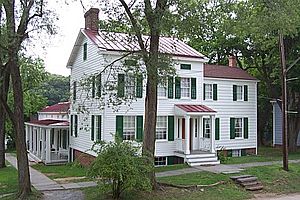Stephens-Black House facts for kids
The Stephens-Black House is an old home from the 1800s. You can find it in Historic Richmond Town on Staten Island, New York City. This special house became a New York City Landmark on August 26, 1969. This means it's an important building that needs to be protected.
Building the House
The Stephens-Black House was built a long time ago, between 1838 and 1840. It stands on a plot of land at Center Street and Court Place. The house was built in a style called Greek Revival. This style was popular back then.
The main floor of the house first had a side entrance hall. It also had two fancy living rooms. Upstairs, there were three big bedrooms. Later, after 1840, another living room was added on the west side. Two more bedrooms were built above this new room. In the basement, there was a kitchen from the 1830s and a dining room. A general store was also added next to the house between 1840 and 1870.
Visiting the House Today
Today, you can visit the Stephens-Black House. It looks like it did around 1860. It has special wallpaper, carpets, and window decorations that are just like the ones from that time. In 2012, the house was even used for filming a TV show called Boardwalk Empire.
Who Lived Here?
Stephen Dover Stephens was the first owner of the house. He was born in 1808. He owned the home and ran the store from 1837 to 1870. Stephen married Elizabeth Johnson in 1829 at Saint Andrew's Church. This church is also in Richmondtown. Their five children were all baptized at the same church. Their names were Stephen Dover Jr., William James, Lucretia, Mary Elizabeth Jr., and Charlotte Ann.
In 1870, the Stephens family sold the house and store to Mary and Joseph Black. The Stephens family then moved to another house nearby. Mr. and Mrs. Stephens lived there until they passed away in 1883. The Black family raised eleven children in the house! They also ran the store until 1926.
After the Black family, Willet and Bertha Conner bought the store in 1926. They ran a post office there until World War II. Later, the house was split into two apartments and rented out. Eventually, the house became part of Historic Richmond Town. That's when it was named a special landmark.


